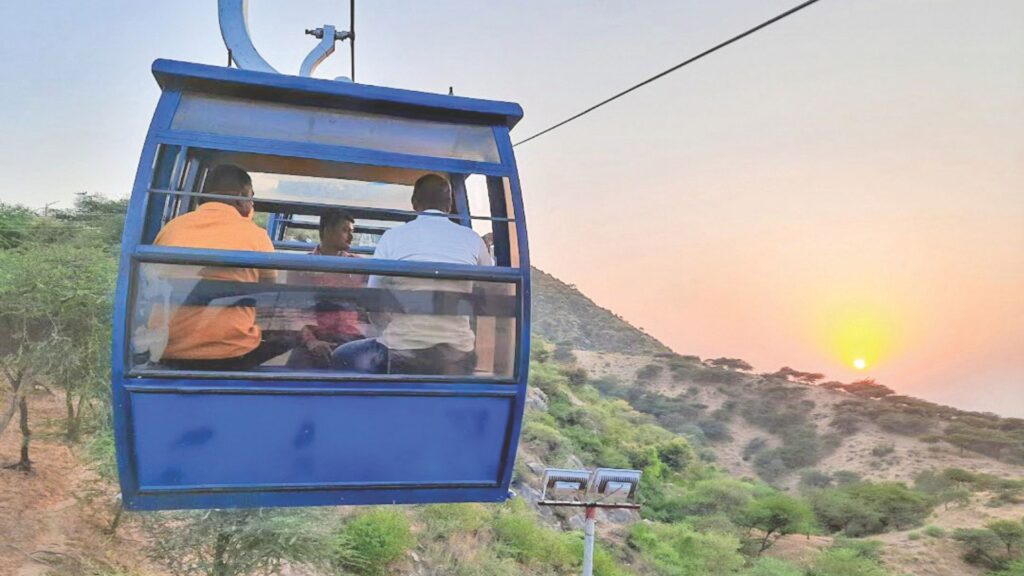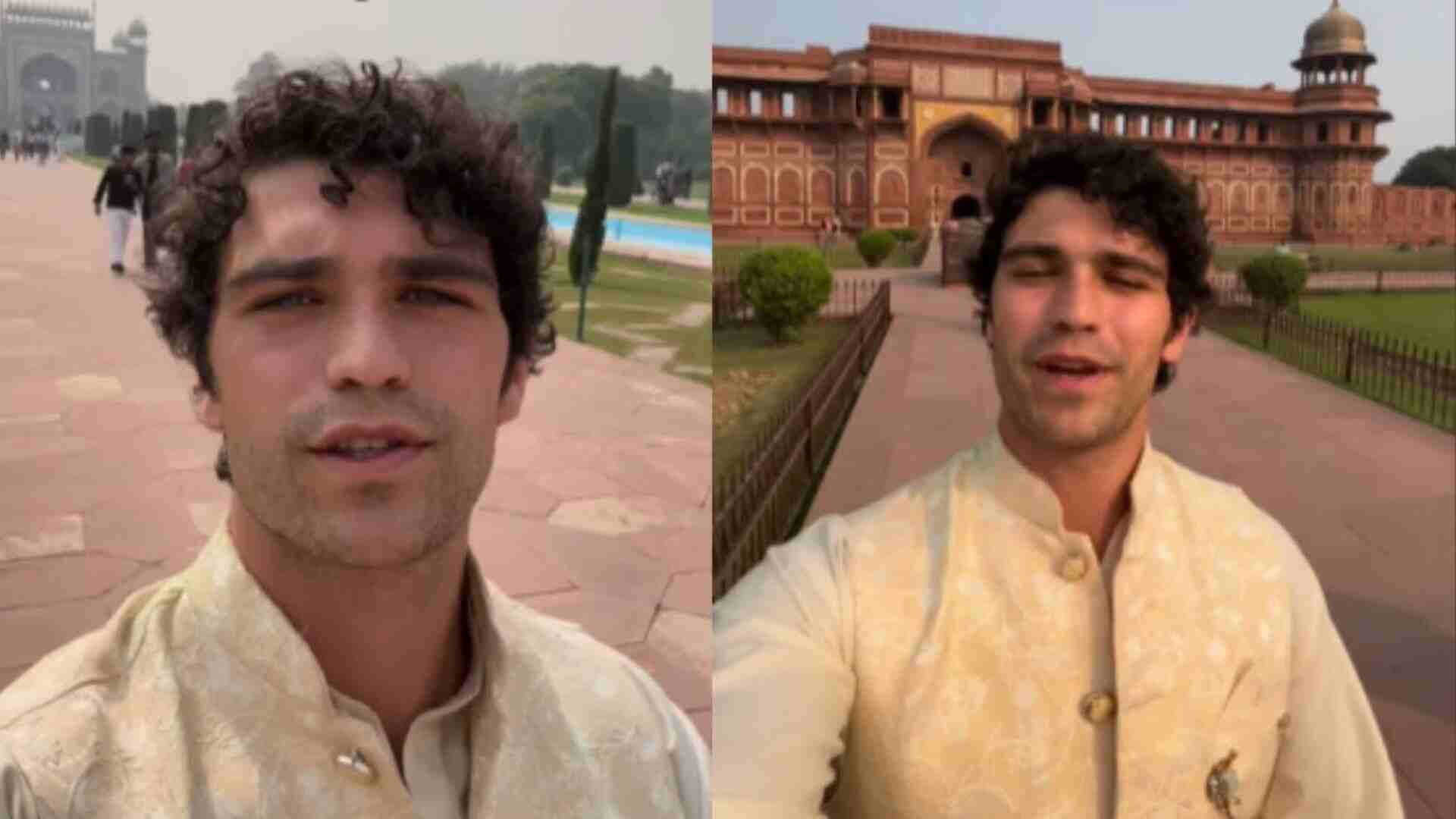
Positioned strategically atop Ratnagiri Hill, Savitri Mata Temple, a sacred shrine rises 800 feet above Pushkar’s sacred lake, offering more than just spiritual solace. The temple, which demands either a climb of 650 steps or a scenic ropeway journey, rewards visitors with panoramic views that stretch across the holy town and into the vast Thar Desert beyond.
Sacred Legacy and Mythological Roots
The temple’s origins are deeply rooted in Hindu mythology, specifically the divine narrative of Lord Brahma and his consorts. According to ancient texts, when Lord Brahma prepared to perform a crucial yajna (fire sacrifice) in Pushkar, his wife Savitri’s absence prompted him to marry Goddess Gayatri to complete the ritual. Upon discovering this, an enraged Savitri retreated to Ratnagiri Hill. The temple, constructed in 1687, marks this significant mythological event and has since served as a powerful symbol of devotion.
The spiritual significance of the shrine extends beyond its mythological foundations. Daily rituals, performed with unwavering dedication, maintain the temple’s sacred atmosphere. During festivals, particularly Kartik Purnima and the famous Pushkar Fair, the temple complex transforms into a vibrant celebration of faith and culture, drawing thousands of devotees from across the globe.
Architectural Grandeur and Design
The temple’s architecture seamlessly blends religious symbolism with structural excellence. Its white marble exterior, characteristic of Rajasthani temple architecture, features meticulously carved panels depicting scenes from Hindu mythology. The main shrine, housing the elegantly crafted idol of Goddess Savitri, demonstrates the exceptional skill of medieval artisans. Multiple chambers surround the central prayer hall, each showcasing distinctive architectural elements that contribute to the temple’s overall grandeur.
Natural light plays a crucial role in the temple’s design. Strategically placed windows and jharokhas (overhanging enclosed balconies) create a dynamic interplay of light and shadow throughout the day. The morning sun particularly enhances the temple’s beauty, casting a golden glow across its marble surfaces and illuminating the intricate carvings with remarkable clarity.
Natural Harmony and Environmental Heritage
The temple’s natural setting contributes significantly to its appeal. Ratnagiri Hill supports a diverse ecosystem, hosting native flora adapted to the semi-arid climate. Desert flora, including hardy shrubs and seasonal wildflowers, dot the hillside, creating a natural garden that changes with the seasons. The hill also provides sanctuary to various bird species, making it a notable spot for wildlife enthusiasts.
Environmental conservation efforts around the temple complex demonstrate a commitment to preserving this natural heritage. The temple trust maintains strict guidelines for waste management and has implemented water conservation measures. Native plant species are protected and promoted, helping prevent soil erosion while maintaining the hill’s ecological balance.
Modern Amenities and Accessibility
Recent developments have significantly enhanced the visitor experience without compromising the temple’s traditional character. The installation of the ropeway system in particular has transformed accessibility, offering a comfortable 5-minute ascent with spectacular aerial views. This modern addition has made the temple accessible to elderly devotees and those unable to manage the steep climb.
The temple complex now features improved facilities including clean drinking water stations, rest areas, and medical aid centers. Enhanced security measures ensure visitor safety, while clear signage helps navigate the extensive complex. Despite these modern additions, careful planning has preserved the temple’s spiritual atmosphere and architectural integrity.
Cultural Impact and Community Engagement
Beyond its religious significance, the temple serves as a cultural nucleus for the region. Regular cultural programs showcase traditional Rajasthani performing arts, helping preserve local heritage. The temple trust organizes educational initiatives about the region’s history and conducts workshops on traditional arts and crafts. These activities strengthen community bonds and ensure the transmission of cultural knowledge to younger generations.

Sacred Geography and Spiritual Experience
The temple’s elevated location creates a unique spiritual environment. The separation from the bustling town below fosters a sense of peace and contemplation. During early morning hours, when mist often shrouds the hill, the temple seems to float above the mortal realm, creating an ethereal atmosphere that enhances the spiritual experience.
The view from the temple complex offers a singular perspective of Pushkar’s sacred geography. The sight of the holy lake, surrounded by ghats and temples, provides visitors with a comprehensive understanding of the town’s religious significance. This elevated vantage point allows appreciation of how the natural and built environments interact in this ancient pilgrimage center.
Practical Considerations and Visitor Experience
Visiting the temple requires some planning. The cooler months between October and March offer the most comfortable conditions. Early morning visits provide the best experience, combining pleasant temperatures with optimal lighting conditions for photography. The temple trust provides guides who can explain the site’s historical and spiritual significance, enriching the visitor experience through their knowledge of local traditions and stories.
The Savitri Mata Temple stands as a remarkable fusion of spiritual heritage, architectural excellence, and natural beauty. Whether approached through the traditional path of climbing the steps or via the modern ropeway, the temple offers visitors a profound experience that combines religious devotion with cultural understanding. In an age of rapid modernization, this hilltop shrine maintains its timeless appeal, continuing to draw those seeking both spiritual enlightenment and cultural enrichment.
Festival Glory and Celebrations
The temple witnesses extraordinary vibrancy during religious festivals and celebrations. During Kartik Purnima, the complex transforms into a magnificent spectacle of lights and colors. Thousands of oil lamps illuminate the steps leading to the temple, creating a mesmerizing sight visible from throughout Pushkar. The Pushkar Fair period brings additional festivities, with special decorations adorning the temple structure and continuous ceremonies marking the auspicious occasion.
Special rituals during these times follow centuries-old traditions. The morning ceremonies begin before dawn, with the blowing of conch shells echoing across the hillside. Traditional musicians perform devotional songs using ancient instruments, their melodies carrying across the valley. The evening aartis feature elaborate rituals, with hundreds of lamps creating a golden glow around the temple complex.
Spiritual Learning Center
The temple complex houses a small but significant learning center where scholars share knowledge about Hindu scriptures and local religious traditions. Regular discussions cover topics ranging from mythology to meditation practices. The center also maintains a collection of religious texts and historical documents related to the temple’s history and the region’s spiritual heritage.
Sunrise Spectacle
The temple’s eastern orientation creates a magnificent spectacle during sunrise. First light touches the temple spires, gradually illuminating the structure from top to bottom. Professional photographers often gather to capture this daily phenomenon, especially during winter months when morning mist adds an ethereal quality to the scene. The play of light on the white marble creates ever-changing patterns, making each sunrise viewing unique.
Community Kitchen and Prasad
The temple operates a community kitchen serving free meals to visitors during major festivals. The kitchen follows traditional cooking methods, preparing prasad (blessed food) according to ancient recipes. Local women volunteer their services, maintaining this centuries-old tradition of spiritual hospitality.
Geological Significance
Ratnagiri Hill, on which the temple stands, holds geological importance. The hill’s composition of ancient rock formations provides insights into the region’s geological history. Scientific studies have identified unique mineral deposits in the area, adding another layer of significance to this sacred site.
Future Development Plans
The temple trust has outlined sustainable development plans focusing on improved visitor facilities while preserving the site’s spiritual essence. Future projects includes Enhanced rainwater harvesting systems, Solar power integration, Digital documentation center, Improved accessibility features, Extended meditation spaces, Advanced security systems.
Impact on Regional Tourism
The temple significantly influences regional tourism patterns. Its presence has helped establish Pushkar as a major spiritual tourism destination. Local businesses, particularly those in the hospitality sector, benefit from the steady flow of visitors. The temple’s growing popularity has led to improved infrastructure in the surrounding area, benefiting both tourists and local residents.
Through centuries of existence, the Savitri Mata Temple has maintained its spiritual significance while adapting to changing times. It stands not just as a religious monument but as a living symbol of cultural continuity, architectural excellence, and spiritual devotion. The temple continues to draw visitors from across the globe, offering them a unique blend of spiritual experience, cultural insight, and natural beauty, all while maintaining its sacred character and traditional values.















